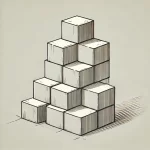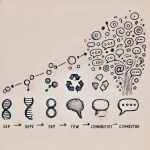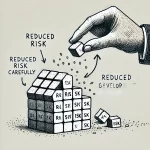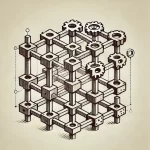Question More, Action Knowledge.
Remember, at QMAK, we don’t just teach; we empower. We don’t just inform; we inspire. We don’t just question; we act. Become a Gold Member, and let’s unlock your child’s full potential, one question at a time.
![]() Have you ever tried to build something complex, like a LEGO set, without following the step-by-step instructions?
Have you ever tried to build something complex, like a LEGO set, without following the step-by-step instructions?
It usually ends up being frustrating and might not even work properly. But when you follow the instructions, starting with a simple foundation and gradually adding pieces, you can build amazing things.
This is the essence of Gall’s Law – the idea that complex systems that work always evolve from simpler systems that worked first.
Think of it like learning to ride a bike. You don’t start with a complex racing bicycle and try to master it immediately. Instead, you might begin with training wheels, then progress to a basic two-wheeler, and eventually work your way up to more advanced bikes as your skills improve.
Gall’s Law states that all complex systems that work evolved from simpler systems that worked. It’s a fundamental principle that teaches us that successful complex systems don’t emerge fully formed – they develop gradually through a process of refinement and adaptation.
There are two key aspects to understanding Gall’s Law:
Complex systems should grow and evolve rather than being designed from scratch.

Each stage of the system must work effectively before adding more complexity.

When people try to create complex systems all at once, they often run into problems:
We can see Gall’s Law at work in many successful systems around us:
Facebook started as a simple college directory before evolving into the complex social network we know today.

Modern airports evolved from simple airfields, gradually adding terminals, security systems, and commercial areas.

Living organisms evolved from simple single-celled life forms to complex creatures through millions of years of gradual change.

Complex languages evolved from simple systems of communication, gradually adding vocabulary and grammar rules.
Understanding Gall’s Law helps us approach complex challenges more effectively:
Reduces Risk: Starting simple and evolving gradually reduces the risk of catastrophic failure.

Enables Learning: Each stage of development provides valuable insights and lessons.
Promotes Adaptability: Systems that evolve gradually are better able to adapt to changing conditions.

Ensures Functionality: By building on working components, you maintain functionality throughout development.

Here are some activities to help understand and apply Gall’s Law:
Remember, Gall’s Law teaches us that the path to complexity is through simplicity. When building any system, start small, ensure it works, and then gradually add complexity.
This approach might take more time initially, but it’s more likely to result in a successful, robust system in the long run.
Cloudy with a Chance of Meatballs offers a delightfully chaotic demonstration of Gall’s Law through Flint Lockwood’s journey from simple food replicator to world-threatening weather machine.
Through Flint’s initial success with basic food production and subsequent spiral into uncontrollable complexity, students witness how complex systems must evolve from simple, working foundations rather than being built from scratch.
The film cleverly illustrates this principle as Flint’s FLDSMDFR moves from producing basic spaghetti to generating food storms and giant meatballs, showing how rushing to add complexity without mastering simplicity leads to system failure.
As viewers follow Flint’s realization that he must shut down his creation and start over with a simpler version, they learn how Gall’s Law applies to any complex system – from food-making machines to real-world technologies.
Through its imaginative premise, the film demonstrates why working simple systems provide the only reliable foundation for building sustainable complexity.
Verse 1:
Like a LEGO masterpiece
Built from blocks with gentle ease
Complex dreams need time to grow
Starting simple, taking slow
Pre-Chorus:
Evolution’s quiet art
Working pieces from the start
Layer by layer, test and learn
Watch the simple pages turn
Chorus:
Simple First, that’s how we grow
Nature always seems to know
Build foundations, make them strong
Simple First, then move along
Verse 2:
Social networks start as seeds
Languages grow word by word
Flying fields become the scenes
Where airports rise, once they’ve learned
(Pre-Chorus)
(Chorus)
Bridge:
In the space between the start
And the dreams within our hearts
Lies a path of patient grace
As complexity finds its place
(Chorus)
Remember, at QMAK, we don’t just teach; we empower. We don’t just inform; we inspire. We don’t just question; we act. Become a Gold Member, and let’s unlock your child’s full potential, one question at a time.